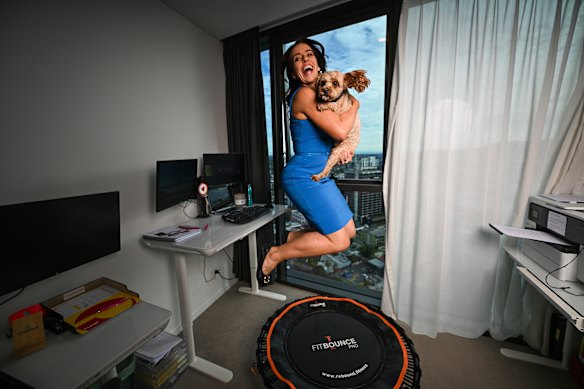Normal text sizeLarger text sizeVery large text size
If Katie Richards doesn’t have a training session booked tomorrow morning, she’ll sleep in until 5am. How the Brisbane lawyer spends the next 16 hours, whether it’s a typical workday in Queensland, or if she’s jetted to Sydney or south Florida, will always follow this rule: If it’s not in her moment-by-moment colour-coded calendar, it’s not happening.
That’s not to say those who manage the two-time founder and CEO’s schedule don’t give Richards some wiggle room. Light green (admin) and dark green (compliance) can be shifted “within reason”, she says, and there’s often “free time” built into her day to accommodate the unpredictable. But they are never, Richards says, allowed to touch the yellows.
“I have to really be on my game,” Richards says. “When you’re doing a lot of talking … you can’t just show up as half a person. You have to have your energy restored for things like that, too, so you can think on your feet.”
Yellow is crucial to Richards, who runs both online law firm Virtual Legal and tele-law platform Law on Earth, and who travels overseas two to three times a year. The yellow colour-coding is in her calendar every morning from when she wakes up until 7am. Yellow is Richards’ label for “health”. And that includes jumping on her mini-trampoline.

In addition to walking her dog or working out, yellow in Katie Richards’ calendar also blocks out her dedicated mini-trampoline time.Credit: Dan Peled
The theory behind ‘microdosing delight’ to alleviate stress
Neuroscientist Dr Rachel Barr, who wrote the book How to Make Your Brain Your Best Friend while completing her PhD on the electrophysiology of memory and sleep, recommends that her social media followers “microdose delight” several times a day – it could be something as simple as spending a few minutes’ listening to your favourite song, or playing with your dog until you feel calm – to help alleviate the compounding effect of chronic stress, of which, Barr says, we are more susceptible than our ancestors.
“We, as modern humans, are now dealing with an environment of stress that is harder for our brains and bodies to cope with,” Barr tells more than 840,000 TikTok users. Delight, Barr argues, is “exactly the right shape” to stop our stress response in its tracks.
Loading
Neurobiologist Dr Natalie Matosin, of the University of Sydney’s Brain and Mind Centre, agrees with Barr’s theory, noting our “dramatically different environment” from when we were cave people, and the modern shift to external stressors being more psychological, than physical, means they are more difficult to escape.
Put simply, as hunter-gatherers, our stress response would cascade once our body knew we’d successfully dodged the saber-toothed cat, our state of calm ushered along by the sprint, the resulting endorphins indicating to our stress receptors that it’s time to lower our cortisol levels.
But you can’t run away from an after-hours text from your boss, and while going for a walk to clear your head, you could easily spend that time ruminating on the situation instead. With the instinctive relaxation response not working for this scenario, it’s harder for those receptors to know the threat has passed. But a small burst of joy would get the message across.
While some stress is good for us – our naturally higher cortisol levels in the morning help us to wake up – a chronic activation of our stress response, Matosin says, is something our bodies aren’t built to handle. Microdosing delight stimulates the neurochemical cocktail – dopamine, endogenous opioids, serotonin, oxytocin and the endocannabinoid system – that suppresses cortisol release, and is a way to tune down our stress system.
“From a biological standpoint, every positive experience makes less space for adverse experience,” says Matosin. “It also inhibits, even if it’s just a little bit, the biological stress response. Whether it turns it off or turns it down, eventually that could have a positive net effect on the way our brain cells connect and communicate.”
Loading
Richards took up mini-trampolining in February, after attending life coach Tony Robbins’ Life & Wealth Mastery course in Fiji. Robbins touts mini-trampolining as a way to stimulate the lymphatic system, which is responsible for helping the body filter out waste and bacteria. But Richards has found it’s become a key way for herself and her employees to de-stress.
“If I can see that one of my staff has just had a difficult call with someone, then we all just say, ‘Straight to the trampoline’,” says Richards, who spent extra on a mini-trampoline that can fold in half and be carried in a case wherever she goes. Richards will often unpack and jump on it for a few minutes to refresh after her “heavy” blue calendar blocks (legal drafting), or on a lunch break.
“We obviously absorb a lot of [clients’] stress as lawyers. When you’re jumping up and down, you don’t think about anything else other than jumping up and down. It completely clears any sort of emotional stress that you’ve just gone through.”
Does ‘microdosing delight’ work for everyone?
It’s complicated, says Matosin. Stress thresholds are specific to the individual – and those who have severe mental health concerns “may not even be able to get to a place where they can experience any delight”. Effective delight dosages, in terms of frequency, activity and duration, vary. But it’s also one of the more realistic wellness habits.
“[Microdosing delight] is a small thing. With behavioural change, I think it’s really difficult for people to overhaul their whole life, like get on an exercise regime, eat vegetables, drink lots of water and get eight to 10 hours of sleep a night,” says Matosin. “But this is achievable because it only takes a moment.”
Dosage, however, doesn’t only concern amount. It’s also about the activity, which Dr Desirée Kozlowski, associate professor of psychology at Southern Cross University and lead researcher for the National Pleasure Audit, says won’t be the same for everyone.
Loading
“Everybody finds pleasure in different things to different extents,” says Kozlowski, who says the concept should be broadened to pleasure, which isn’t confined to delight’s novelty stipulation. “We all have different personalities. We have different genetics. We have different learning; we have different sociocultural influences. All of those things affect what it is that we find pleasurable.”
Richards needs to get away from her screen. Kozlowski finds enjoyment in music and ocean swimming. But game developer Marin Cristian-Ovidiu, CEO of OnlineGames.io, finds digitally playing five-minute rounds of classic arcade games (think Pac-Man, Galaga, Metal Slug) essential to resetting his mental state.
“When I’m deep in strategy meetings, product road maps, or investor calls, those few minutes of gameplay aren’t ‘work’ but kind of like a throwback to why I got into this space in the first place,” says Marin, who finds traditional de-stress methods like breathing exercises more like work. “It feels nostalgic.”
Kozlowski, who is also an advocate for savouring the small moments, says her general advice is “dose yourself up as much as you possibly can” with pleasure as “the more moments of reprieve you can grab, the better it is”.
“If you feel your shoulders let down … or the buzzing has gone from your head, then you’re doing the right thing,” says Kozlowski. “If you wait for great big pleasures like an overseas trip, or falling in love or buying a new car, it’s not enough. Because your stressors are coming thick and fast every single day, you need to be heading those off with these restorative moments every single day.”
Start the day with a summary of the day’s most important and interesting stories, analysis and insights. Sign up for our Morning Edition newsletter.
